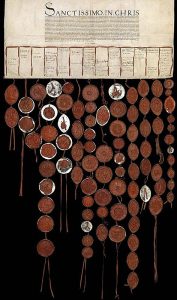In 1493, on his second voyage to the Americas, Christopher Columbus discovered Puerto Rico, an island that he named San Juan Bautista. On his first trip, Columbus, as we know, discovered La Española (Hispaniola), which is today the countries of Haiti and the Dominican Republic. In a failed attempt to reach La Española on his second trip, Columbus landed on Puerto Rico, where he was received by the Taíno Indians, who were of the same ethnic group as the people of La Española and the other islands in the Caribbean.1
Months after reaching the Island, the Spaniards started the process of colonizing the Taíno Indians, led by Juan Ponce De Leon, who was one of the conquistadors that came with Columbus. Later, in 1508, De Leon became the first governor of San Juan Bautista. During this process of colonization, the Taíno Indians did not show resistance because they believed the Spaniards were gods. The reason they saw the Spaniards as gods was because there had been a Taíno legend that spoke of a time when gods were going to rise from the water to give salvation to the Taíno. This legend facilitated the process of colonization for the Spaniards, since they did not encounter any native resistance. Within a short time they had created villages and colonies. By the beginning of the 1500’s, the Taíno natives were working in gold mines and plantations. In 1514, the Taíno decided to take matters into their own hands and rebel against their Spanish overlords. What resulted was one of the most brutal genocides in Latin American history. More than 25,000 Taíno Indians were murdered by the Spaniards on the Island of San Juan Bautista. This means that 85-90% of their population had been killed at the hands of the Spaniards. After the rebellion, the Spaniards noticed that the natives that had survived were not enough to fulfill their labor requirements. They decided to search for a new work force.2
After the massacre of 1514, the Spaniards noticed that they needed a new “work force,” as they called their slaves; so in 1518 they started importing African slaves from the Gulf of Guinea. The slaves started to reach the island later that year, and became the new “work force” of the Spaniards along with the small number of Taíno Indians that had survived the massacre. This caused more problems, since the Spaniards and the Africans brought a variety of diseases to the Island, such as small-pox and measles. Approximately two million Taíno Indians that lived on the islands of the Caribbean died from these diseases. By the late 1500’s there were no more Taíno Indians left on the island of San Juan Bautista; only the children of those who intermarried with the Spaniards and Africans survived. Of course, the Taíno, Africans, and Spaniards intermarried through time, and this is why Puerto Ricans today have such a diverse racial heritage; but the original Taíno racial group became extinct by around 1600. By that time the island of San Juan Bautista had become one of the most important colonies in the Caribbean. The Spaniards now had a way to export their products to the rest of the Caribbean and Latin America through this island, giving them an economical advantage. In less than thirty years the Spaniards took the Taíno land, men, women, and children, and virtually erased a whole population from the face of the earth. Most people consider Christopher Columbus as one of the greatest explorer to ever live, and as a hero of sorts, but have they taken into consideration the many civilizations in the Americas that have been affected by him? Not only the Taíno population, but also the Aztecs, the Incas, and many other societies throughout the Americas were affected significantly by this Columbian moment in history.3
- Roberto Marquez, “Sojourners, Settlers, castaways and creators: A recollection of Puerto Rico past and Puerto Rico present,” Massachusetts Review 36, no. 1 (1995): 94. ↵
- Robert M. Poole, “What Became Of The Taíno?” Smithsonian 42, no. 6 (October 2011): 58. ↵
- Byron Cannon, “West Indian Uprisings,” Salem Press Encyclopedia (January 2016): 583-586. ↵



64 comments
Mario Sosa
This was an interesting read, as it shows a much darker aspect of Christopher Columbus that many people are not aware of. I also believe that more people should learn about what happened to the Taino natives before they start glorifying Columbus. It was very unfortunate that genocide had to be one of the products of the Age of Exploration.
Tina Valdez
I had no idea I was so little informed about the discovery of what is now a part of my country. In less than thirty years the Spanish erased an entire population. That is simply shocking! Great article. You told the history behind it very well.
Maalik Stansbury
Who knew that it went to this level to wipe out tribes because of who they believe in. This sounds so upsetting, a messed up thing to even think about. How could someone do this over something like this, why why would someone do this. I love this article and all the information put into it, including how it was written. Great job.
Christian Lozano
It is rather ironic to read about Christopher Columbus and the Spaniards committing genocide and atrocities against the Tainos considering the Spaniards were most likely raised as Roman Catholics, a very poor presentation of True Christianity to the Natives and Slaves indeed. Deeply Saddening, great article.
Mariana Sandoval
It’s interesting to see the parallels between the colonization of the Aztecs and the colonization of the Taíno Indians. It’s believed that the Aztecs had a similar legend like the Tainos that led them to accept their colonization from the Spaniards. It’s amazing to see that even across a vast ocean, some of the same ideas between the indigenous peoples existed.
It’s very sad to see that the Taino Indians were all killed in the process of colonization. Usually a large percentage is killed due to disease and brutality, however, it’s shocking to see that so early on in their conquest, the Spaniards were able to destroy an entire group of people completely.
This article is a good article to educate people on one of the reasons for why people don’t want to celebrate Columbus day.
Kimberly Rios
This article was very interesting and informative as it taught me many things I had not known beforehand! Growing up students are taught to glorify and praise Christopher Columbus, but in all reality he was not a good person. Reading about how they wiped out over two million people breaks my heart. I was not completely aware about the damage and how far the Spaniards went when taking over land but after reading your article I now have knowledge on this. Interesting and informative article!
Mehmet Samuk
I have a lot of friends from Puerto Rico and I never knew their history. I enjoyed reading this article and I found it very informative. I was shocked that 2 million people were almost wiped out. I believe this a genocide.
Jezel Luna
This article made me aware of a historic event, that prior to reading, I was not familiar with. When I was reading, I was glad that Taino natives finally decided to fight back. Unfortunately, I was devastated to hear that it caused them to lose more than 25,000 Taino Indians. I could not believe that the Spaniards managed to wipe away all existence from the Taino Indians. Everyone saw Christopher Columbus as a hero but now what would they think?
Celina Resendez
It’s crazy to think that in just the span of thirty years, two million people, an entire race, was completely wiped out. I agree that everyone glorifies a lot of the explorers in our history, but no one really looks at the serious damage many of them have done to the native people in the area. Imagine how different life would be if many of these extinct tribes were still around.
Aylin Salinas
Wow, this was a very eye-opening article! The Taíno Indians along with many other tribes were all wiped out due to their belief that their God was going to come back to them one day. It’s astounding how the Spaniards quickly wanted to replace their “work force” after killing them all. The Taíno Indians alongside many other tribes were all taken advantage of by conquerors because they all seemed to have arrived at the same times that they [their God(s)] were said to come back to save them.